En bloc resection of an anterior tumor (T1 to T12)
1. Introduction
En bloc resection of a primary tumor is a significant undertaking, even in the most experienced hands. We therefore recommend referring these cases to quaternary centers with experience in primary spine tumor surgery.
En bloc resections
Terminology is essential in primary tumor management.
An en bloc resection refers to a surgical attempt to remove a tumor in one piece without violating it.
On the other hand, an intralesional resection or a curettage refers to a deliberate intralesional resection.
An en bloc resection needs to be associated with a pathological margin description to be correctly defined.
Four types of margins are described:
- Intralesional – resection margin is within tumoral tissue
- Marginal – resection margin is within a reactional zone or pseudocapsule (in the spine, the epidural margin is often marginal)
- Wide – resection margin is within normal tissue
- Radical – this is extracompartmental resection and, as such, does not apply to spine tumors
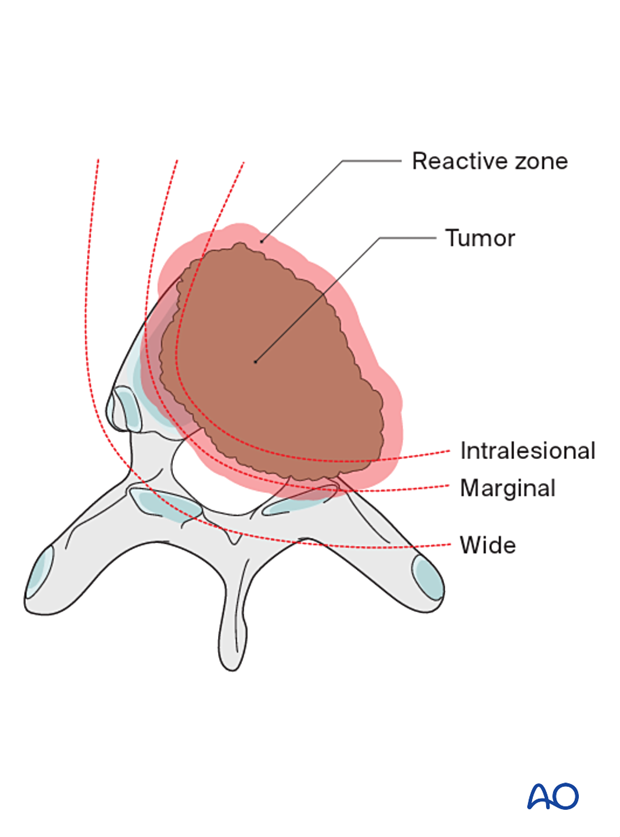
Feasibility
Two conditions need to be met for an en bloc resection to be deemed possible:
- If we consider the spinal canal as a ring, there needs to be enough circumference of that ring to be removed piecemeal to allow delivery of the neural element
- Access to the nerve root sleeve at its dural origin is required
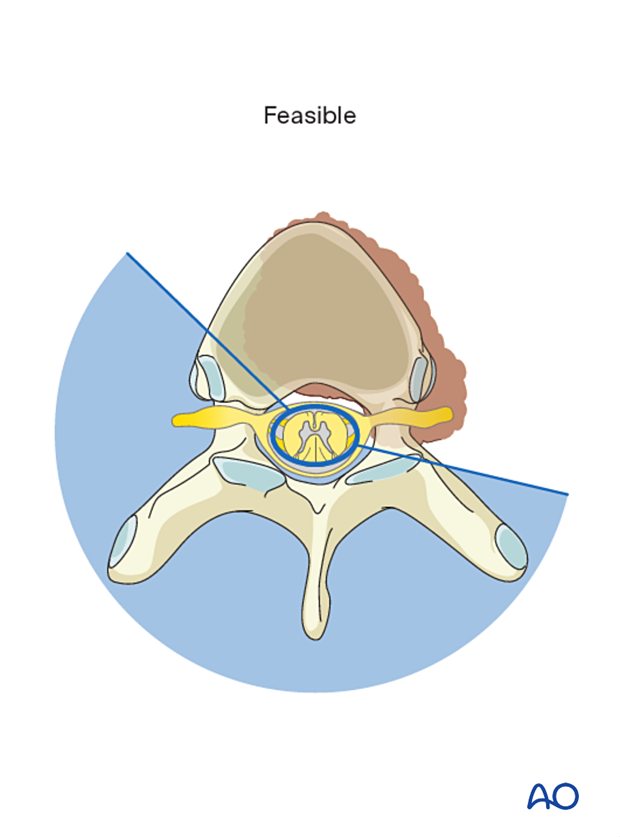
If these conditions are not met, an en bloc resection will not be possible without a planned transgression of the tumor.
In this illustration, the spinal canal is circumferentially surrounded by a tumor. There is not enough uninvolved portion of the ring to allow an en bloc resection.
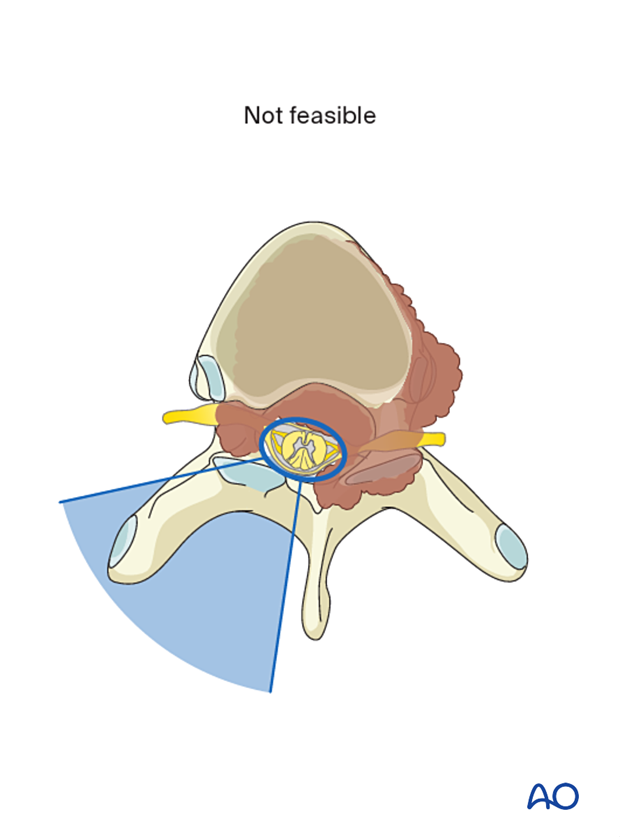
2. Planning
Preoperative management
Proper planning is instrumental in the management of primary spine tumors. A multidisciplinary approach may be required depending on the localization of the tumor.
Embolization
Embolization procedures are recommended to reduce operative blood loss in hypervascular tumors, especially during more extensive resections.
Embolization should be considered for hypervascular tumors, such as giant cell tumors, aneurysmal bone cysts, and hemangiomas.
The role of the embolization is:
- To reduce the vascularity of the tumor
- To facilitate dissection around the tumor
- Mapping of spinal cord vascular supply
Embolization on its own may also have a therapeutic effect.
This picture shows a T11 Ewing sarcoma.

Resection strategy
As thoracic nerve roots can be ligated without significant neurological deficit, thoracic tumors involving the vertebral body can typically be delivered and reconstructed through a posterior-only approach. However, T1 and T2 nerve roots should be preserved to avoid neurological deficit of the hand.
A thoracotomy may be required to assist with the ventral dissection and may be safer when the tumor is in close proximity to important vascular structures. Also, a posterior-only approach at the thoracolumbar junction may be challenging because of the crus of the diaphragm. As such, a staged anterior/posterior procedure could be advisable.
During the posterior approach, the uninvolved part of the spinal ring will be resected in a piecemeal fashion, and osteotomies and soft tissue dissections will be performed.
A wide visualization is essential in these cases, and a laminectomy involving one level above and below the tumor is recommended.
The goal is to achieve:
- Good visualization of normal and abnormal anatomy
- Safe decompression of the neural elements
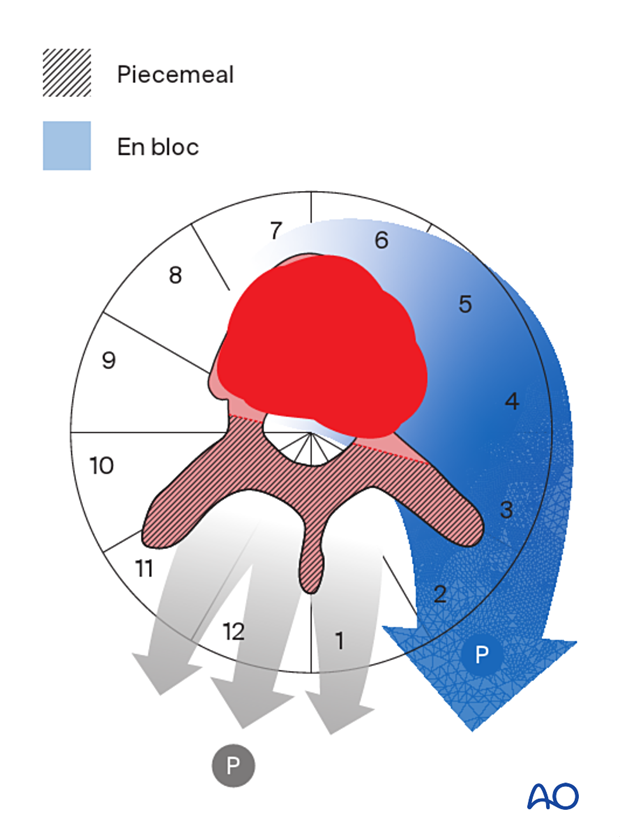
Reconstruction strategy
En bloc resection is a destabilizing procedure. As such, long constructs are required.
Generally, three vertebrae above and below the tumor are included in the construct. In multilevel tumors, or when there is poor bone quality, this construct can be extended.
The risk of implant failure may be decreased by cement augmentation of fenestrated screws in patients with poor bone quality. Alternatively, other techniques like hooks or sublaminar wires can be used.
As the procedure is often curative, it is important to verify that the spine is reconstructed in good alignment, and a solid bony union should be attempted.
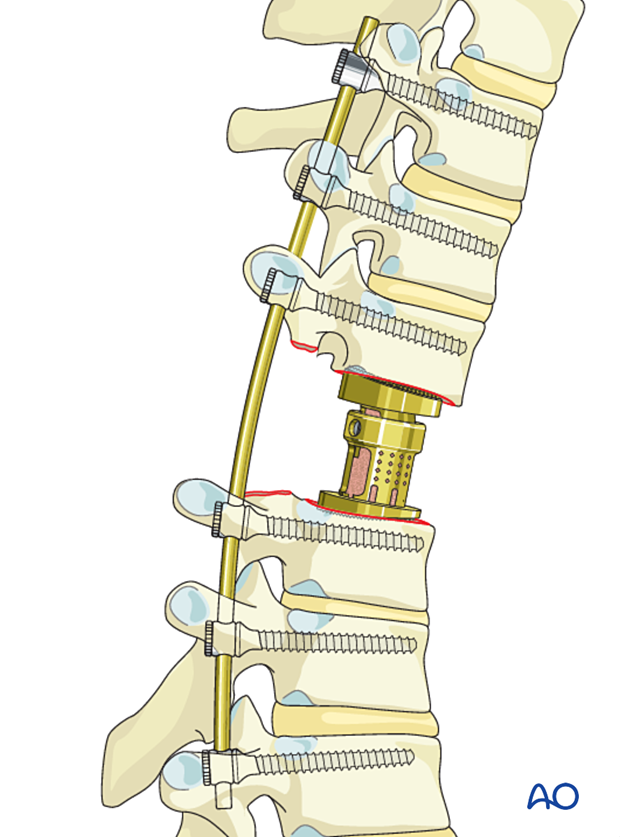
Case-based scenario
Every case is unique.
To illustrate the surgical principle of a posterior-only en bloc resection with posterior release and delivery of a thoracolumbar tumor involving the vertebral body, we will use a T6 tumor located in segments 4–9 of the WBB classification.
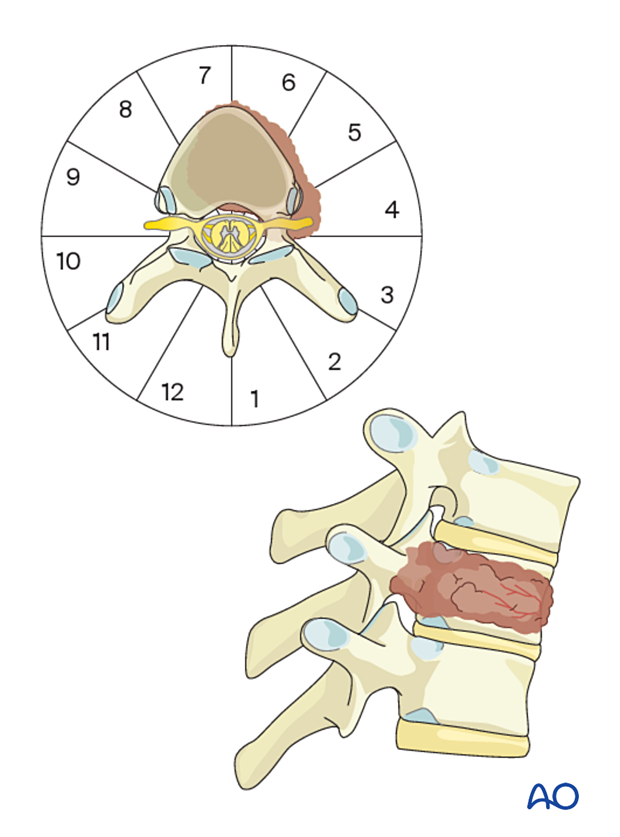
3. Patient preparation and surgical approach
Patient preparation
The patient is placed prone.
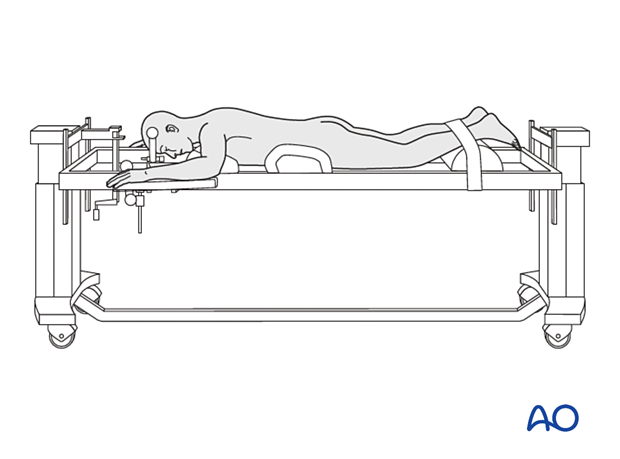
Surgical access
The posterior midline incision is used.
A wider dissection will typically be performed for primary tumors compared to a trauma case.
Careful analysis of the preoperative imaging is important to avoid tumor violation during the approach.
Following a midline incision, the subcutaneous tissues are dissected down to the chosen dorsal plane of dissection.
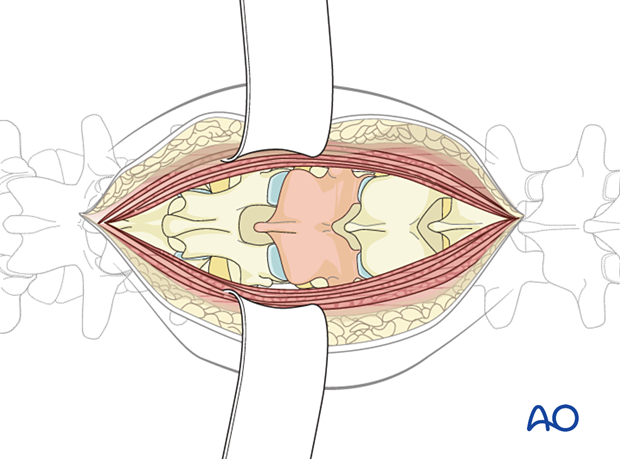
The incision may need a cranial extension when the tumor involves the upper thoracic spine.
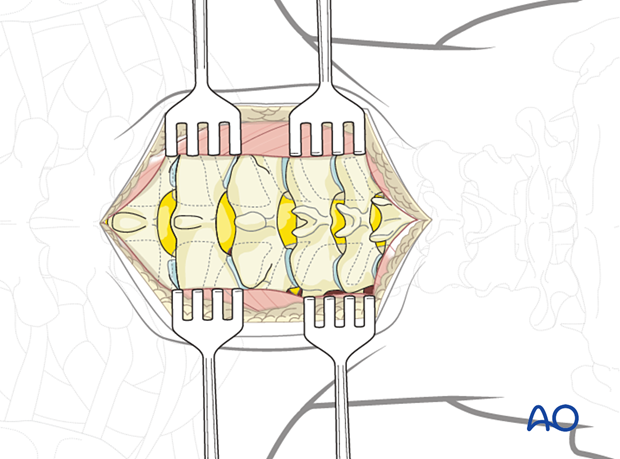
4. Instrumentation
Screw insertion
Insert all screws according to the preoperative plan.
Optimal pedicle screw purchase will, in order of importance, be achieved by:
- Selecting the largest possible screw diameter according to the pedicle diameter
- Selecting the longest possible screw
- Positioning of the screw under the cranial endplate
- Cement augmentation of the screw

Thoracic pedicle screws are inserted according to the standard technique.

Rod preparation
Every effort should be made to contour the rod to decrease the risk of induced sagittal or coronal malalignment.
For further details about sagittal spinal alignment, refer to this section.
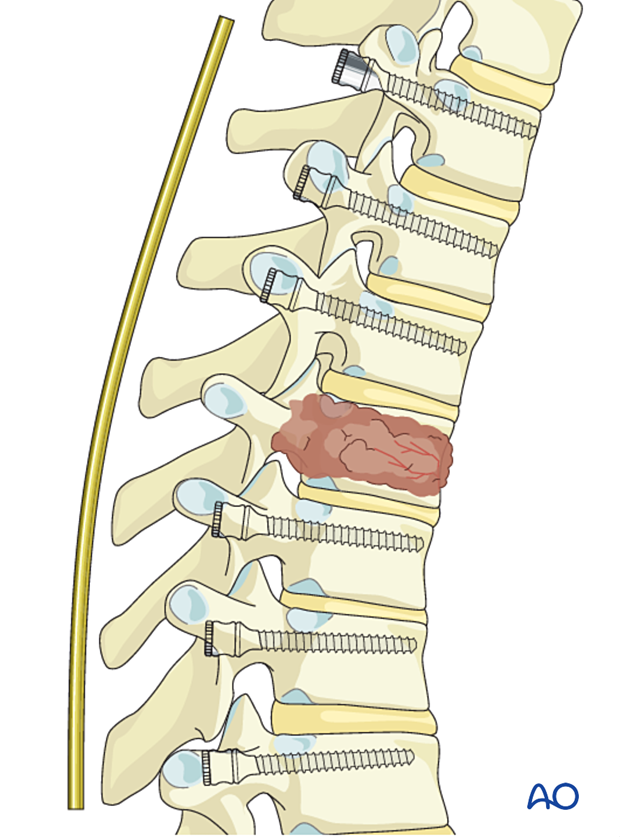
Cervicothoracic instrumentation
Extending instrumentation to the cervical spine may be necessary when the tumor involves the cervicothoracic junction.

5. Tumor resection
Laminectomy
Perform a laminectomy according to the preoperative plan.
Dissection should progress from normal to abnormal tissues to protect normal neurological elements and facilitate dissection.
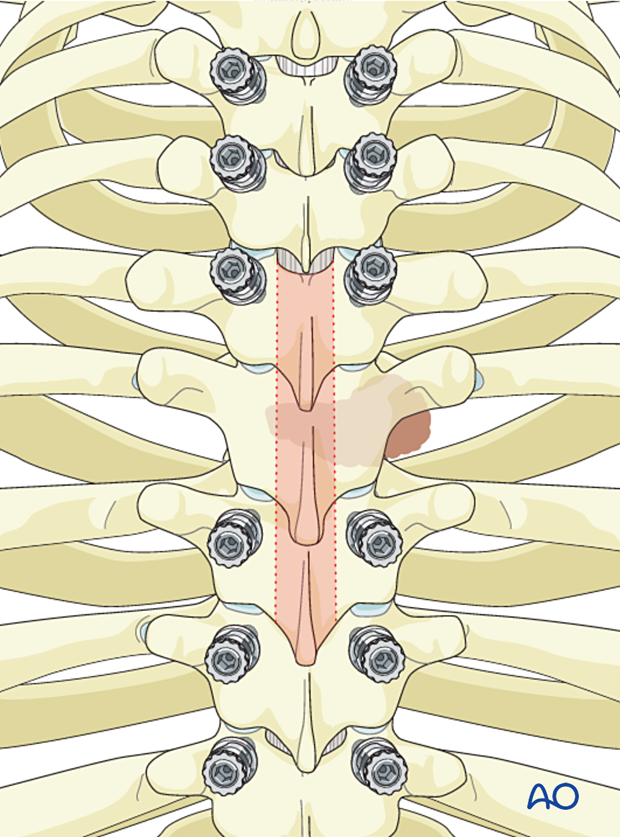
Bony release
Perform an osteotomy of the inferior facet of T5 and T6 bilaterally.

Perform an osteotomy of the superior facets of T6 and T7 to visualize the disc spaces.
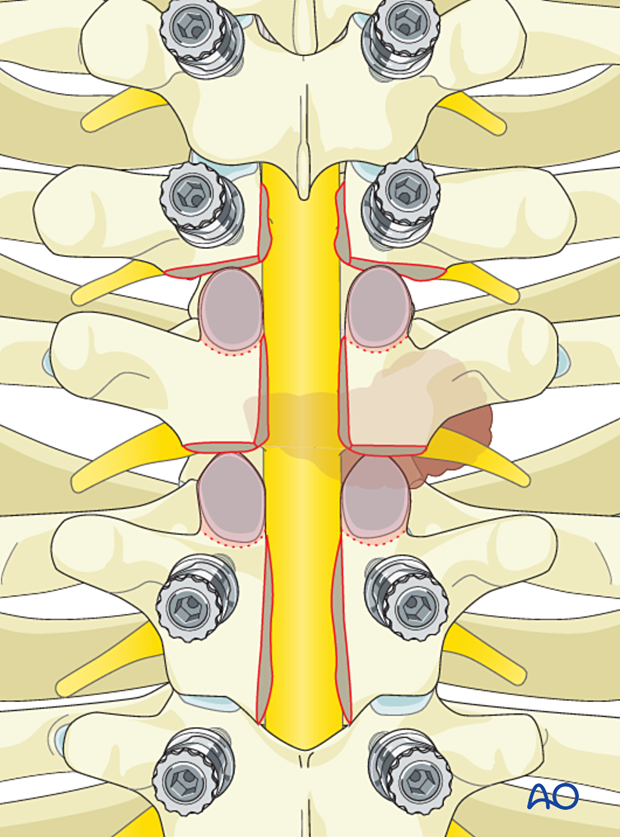
Isolate the T6 pedicles and resect the uninvolved pedicle(s).
If uninvolved with the tumor, resect the transverse processes of T6 (highlighted in red) and the uninvolved T6 pedicle.

Dissection of nerve root
Isolate and dissect the nerve root laterally.
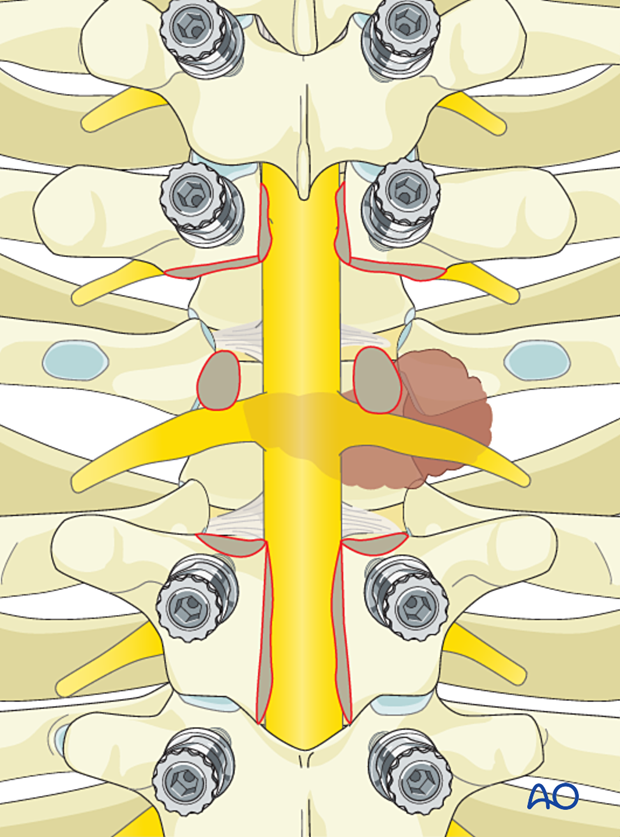
Anterior dissection
Disarticulate the uninvolved costotransverse and costovertebral joint(s).
Remove the uninvolved rib head(s) of T6 and T7, as well as the transverse processes of T7. It is important to be able to see the lateral aspect of the T5/T6 and T6/T7 disc spaces.
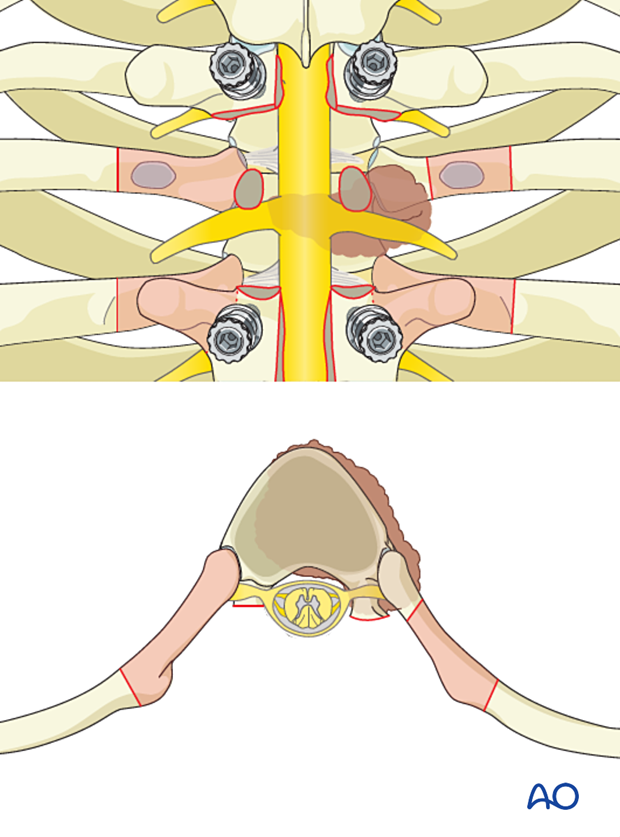
Develop a plane anteriorly around the vertebrae/tumor.
Care should be taken not to violate the tumor capsule while doing the lateral dissection.
A finger can be used to do the blunt dissection in the front of the vertebral body.
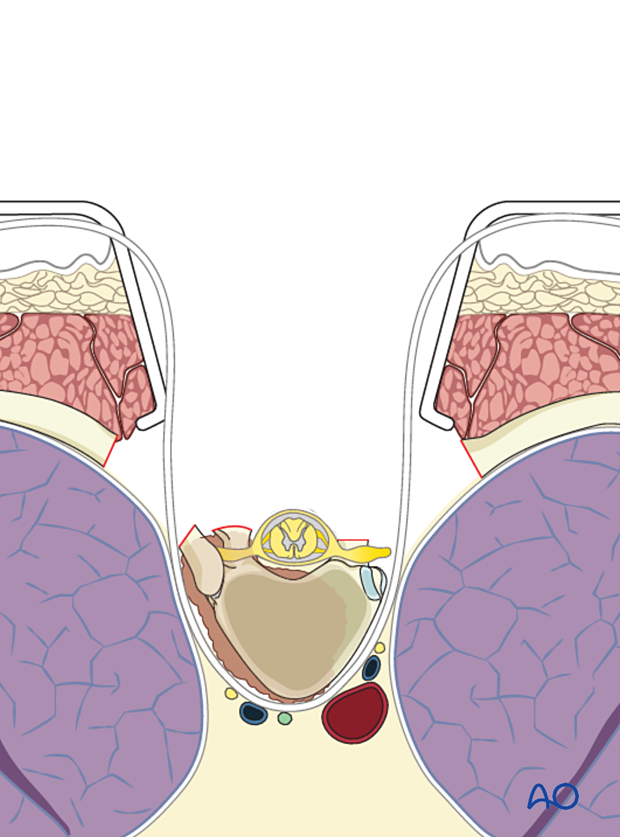
Nerve root ligation
Ligate the T6 nerve root bilaterally.
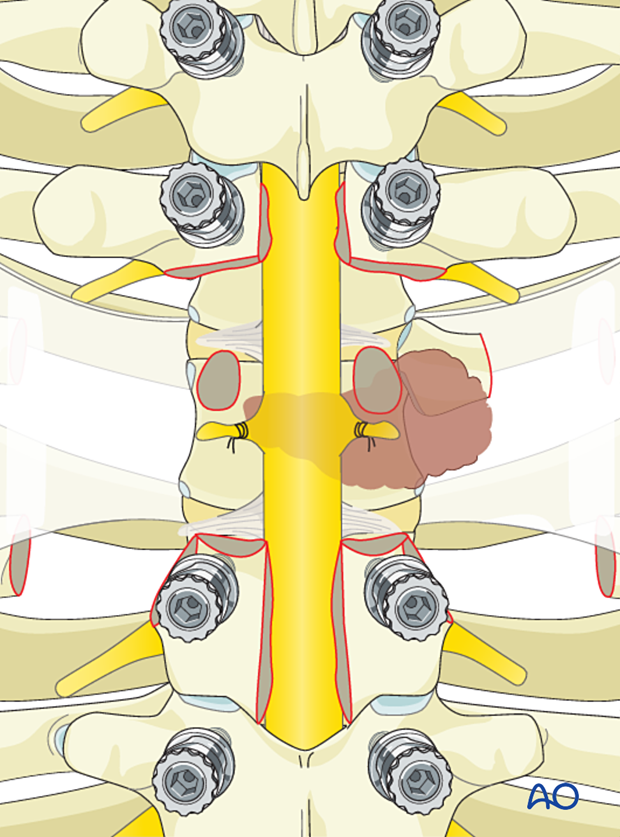
Release of anterior column
Identify the T5/T6 and the T6/T7 discs and perform an epidural dissection outside of the tumor pseudocapsule.
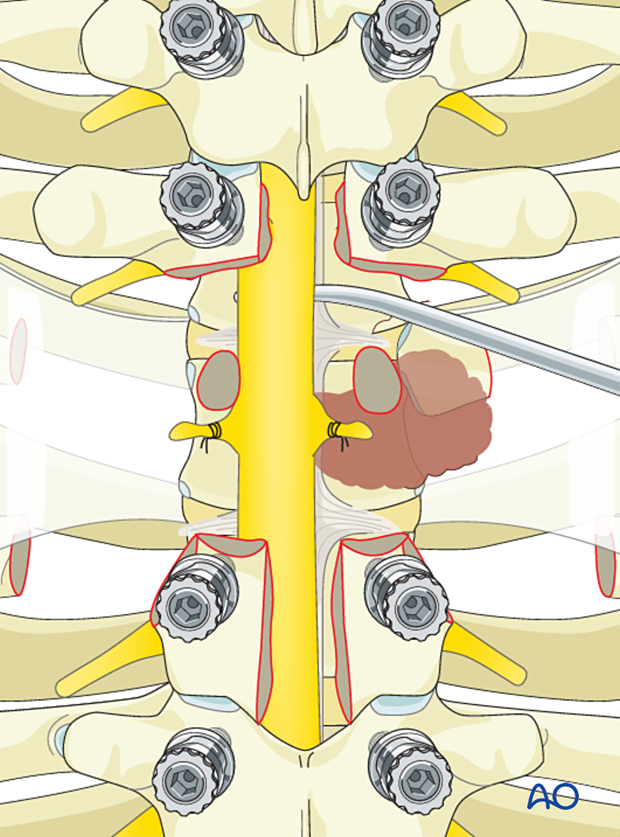
Transect the PLL at the level of the T5/T6 and the T6/T7 disc.
The transected PLL will be delivered together with the tumor through the anterior approach.
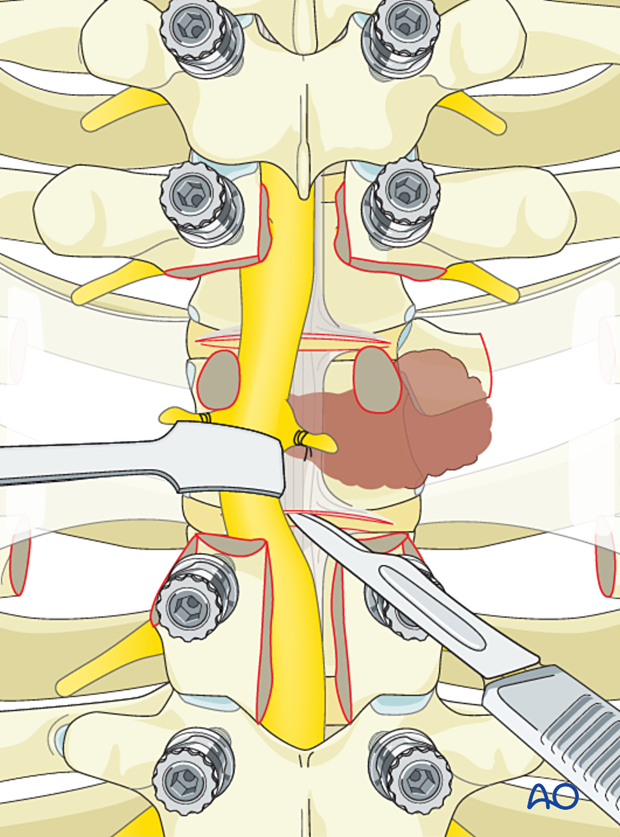
The disc space is opened laterally as anteriorly as possible.
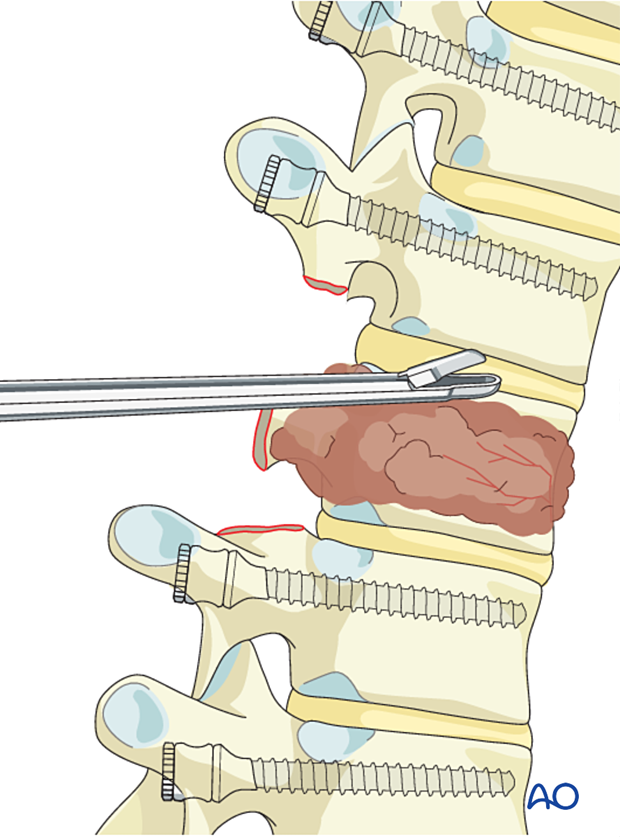
Insertion of contralateral rod
Insert a contralateral temporary rod to stabilize the spine and avoid spinal cord injury.
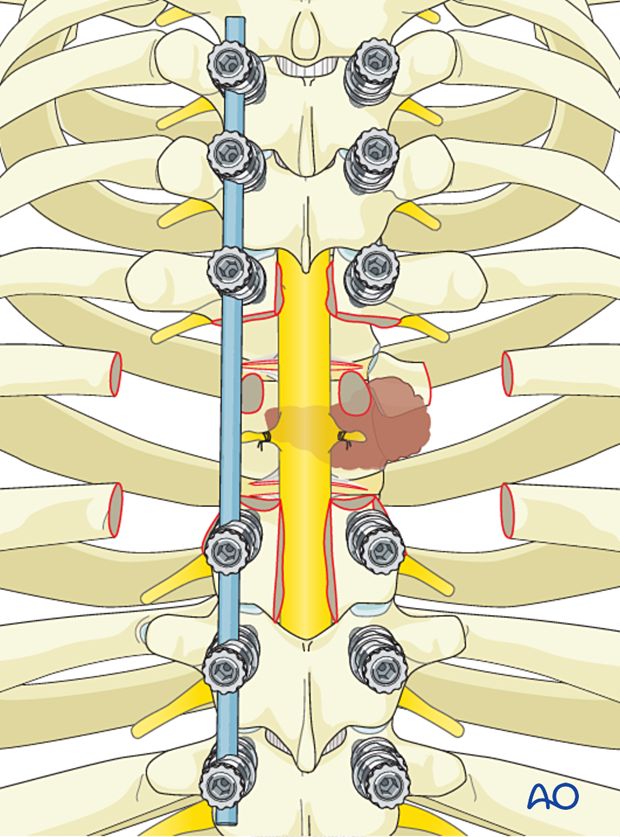
Position the Tomita saw at the T5/T6 and the T6/T7 disc, anterior to the vertebral body and the thecal sac.
Place the saw so that it is well seated in the disc spaces where the ligament was cut laterally.
Once the saw is well positioned, then the disc spaces can be transected using a back and forth movement with the saw.
Great care must be taken not to damage the spinal cord while cutting the disc with the Tomita saw. A finger can be used as a fulcrum to keep the Tomita saw down and away from the thecal sac.
Aside from the Tomita saw, other instruments could be used to disconnect the tumor rostrocaudally. These include scalpels, bone scalpels, disc dissectors, and osteotomes.
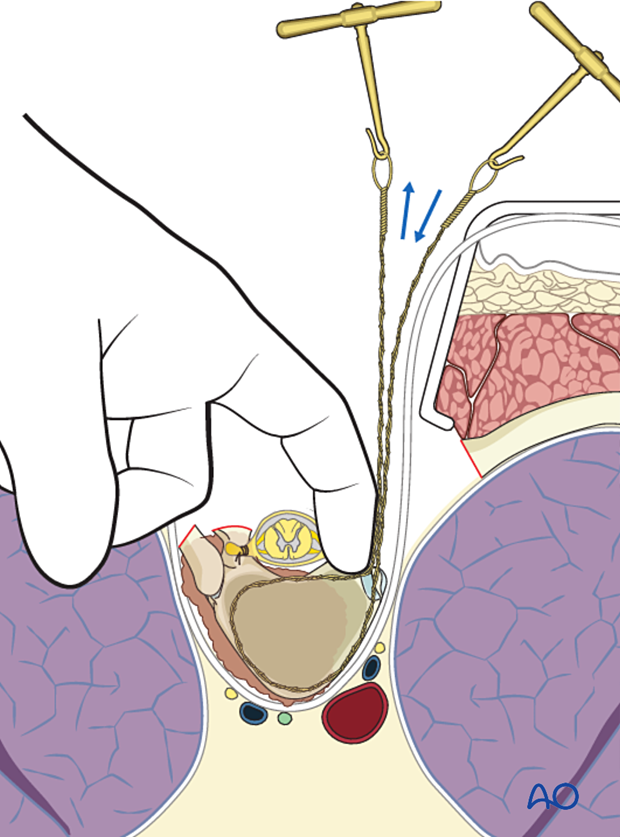
Tumor delivery
Ensure that there are no soft tissue adherences circumferential to the vertebra body.
The tumor is delivered by rotating the vertebral body around the thecal sac.
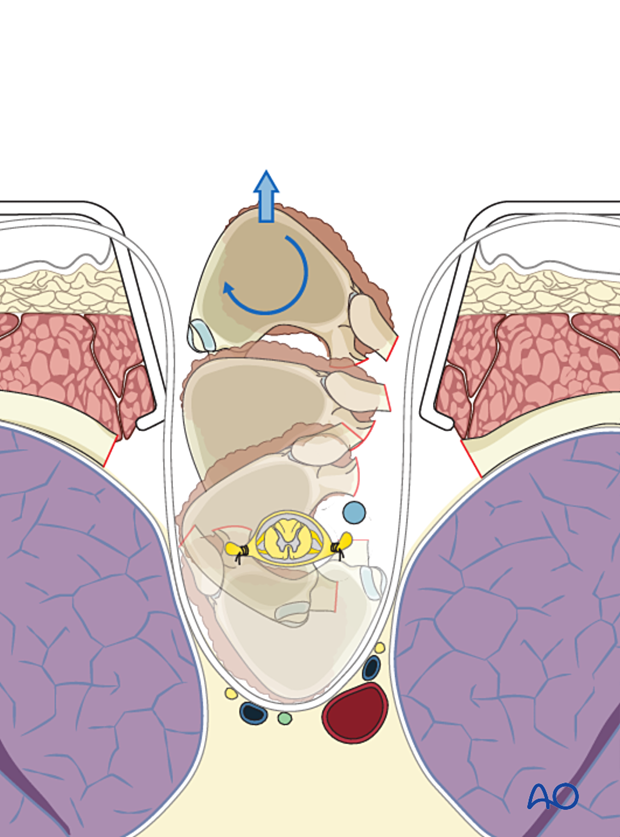
6. Vertebral body reconstruction
Discectomy
Incise the annulus fibrosis and remove the disc using a series of Kerrison rongeurs and curettes.
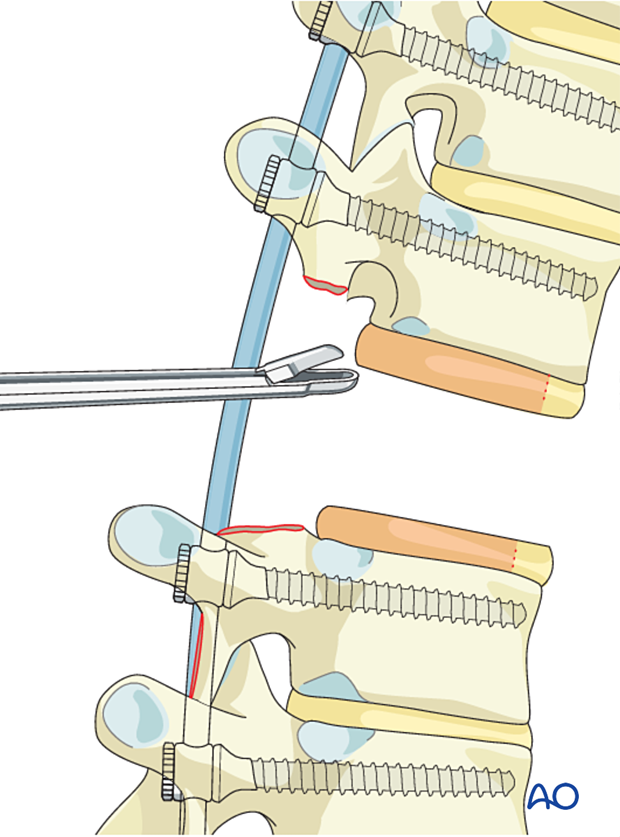
Prepare the endplates for fusion.

Cage insertion
Use calipers and implant templates to measure the height of the defect.
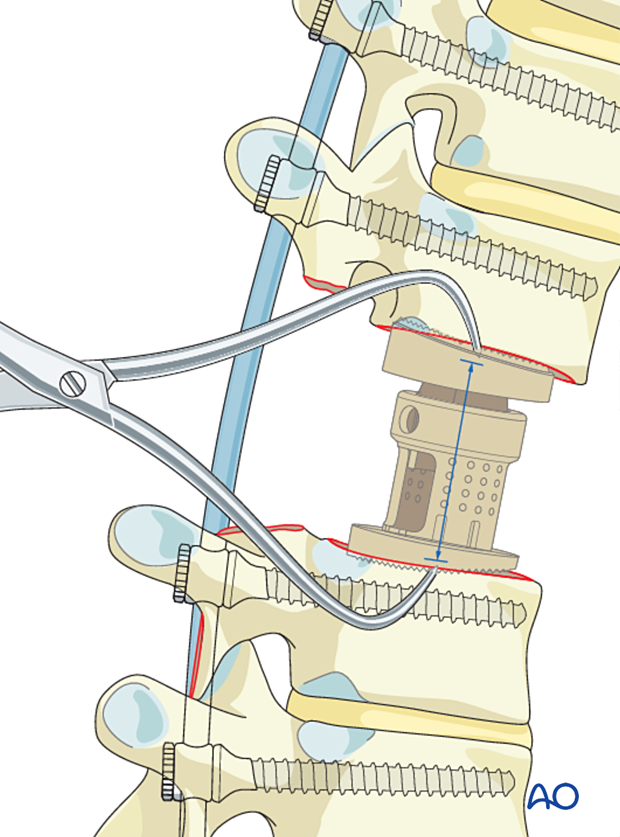
Insert the prosthesis posterolaterally and expand it until the appropriate spinal alignment has been achieved.
Great care must be taken not to over-distract the cage, as this can lead to spinal cord injury.

Bone grafting
Additional bone grafting can be used from the removed rib or allograft. Every effort should be made to achieve a solid bony fusion in this patient population.

Insertion of final rod
Complete the rod insertion.
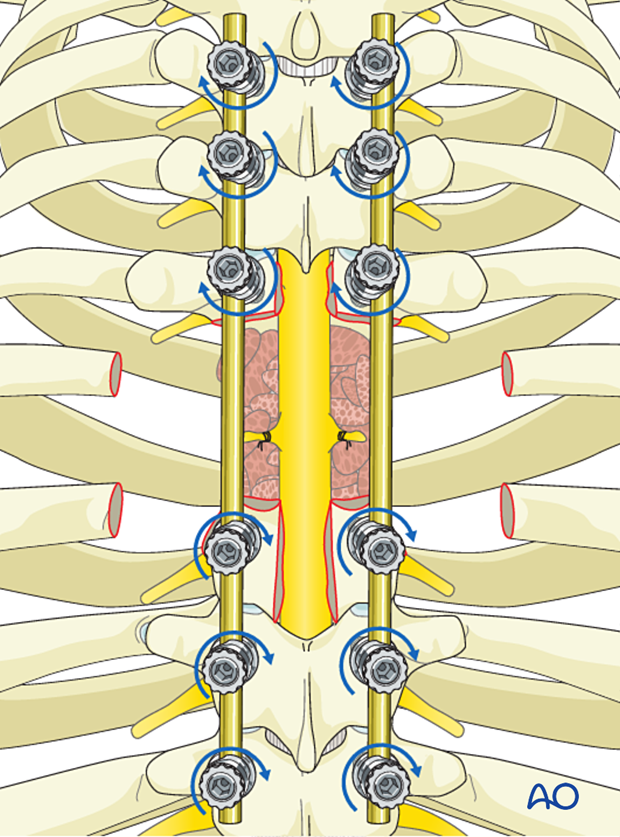
The final construct is shown from a lateral view.
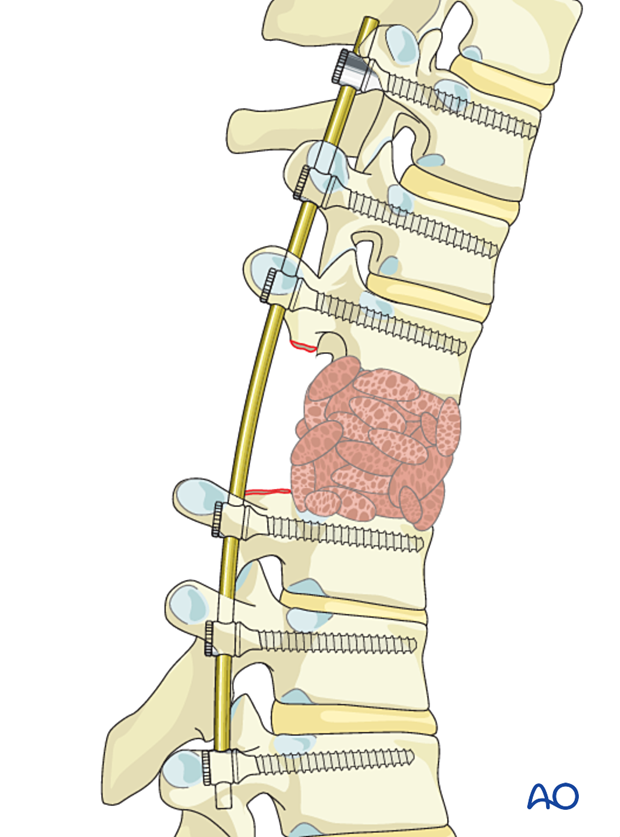
7. Fusion
Preparation for fusion
Excise the facet capsule and denude/curette the joint surface cartilage surfaces and the posterior cortex.
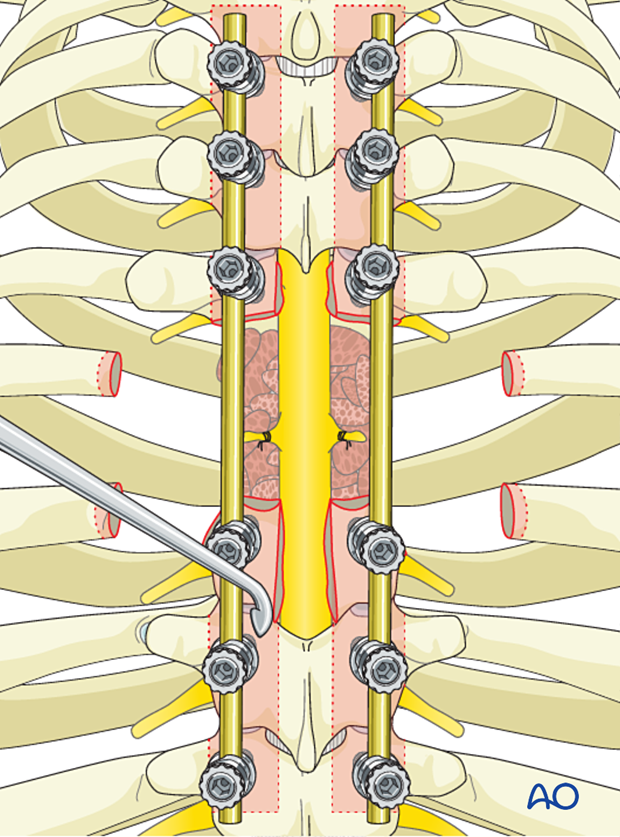
Grafting
Insert pieces of bone graft (autograft, allograft) into the decorticated facet joint for fusion.
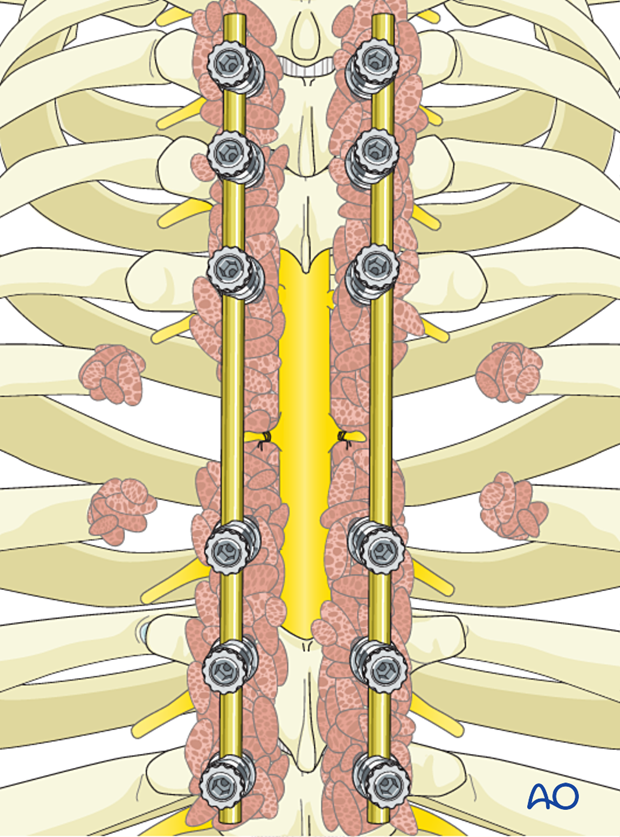
8. Intraoperative imaging
Before wound closure, intraoperative imaging is performed to check the adequacy of reduction, position, and length of screws, and the overall coronal and sagittal spinal alignment.

Lateral view of the above case

9. Posterior closure
Perform a multilayer closure as described in the approach.
For patients undergoing tumor surgery and/or with a history of radiation:
- Plastic surgery should perform soft-tissue reconstruction to decrease the risk of wound complications
- Intrawound vancomycin can be applied to decrease the risk of postoperative wound complications
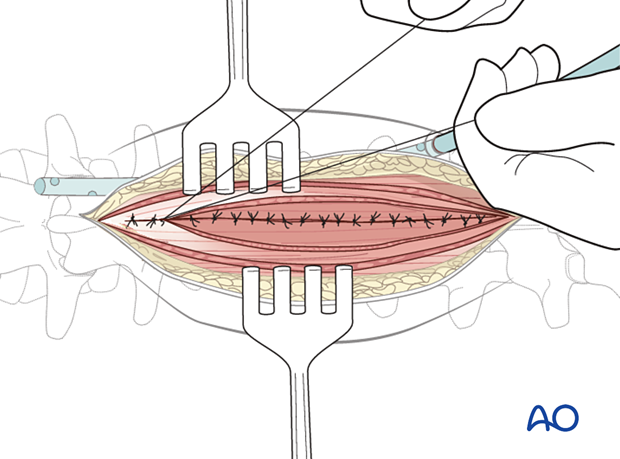
10. Aftercare
Patients are made to sit up in bed on the first day after surgery. Patients with intact neurological status are made to stand and walk on the first day after surgery.
Patients can be discharged when medically stable or sent to a rehabilitation center if further care is necessary.
Throughout the hospital stay, adequate caloric intake of a high-quality diet should be monitored.
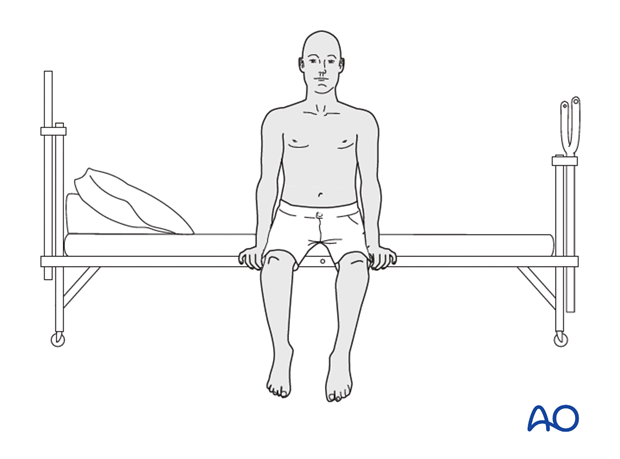
Patients are generally followed with periodical x-rays at 6 weeks, 3 months, 6 months, and 1 year to monitor for hardware failure and with an MRI every 6 months for tumor surveillance.
Some primary benign tumors of the spine can recur years after surgery, and long-term tumor surveillance is important.













